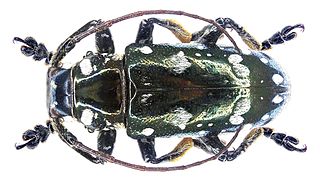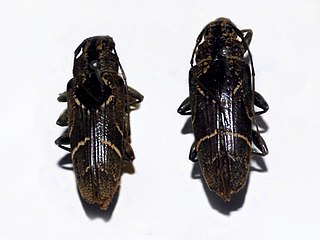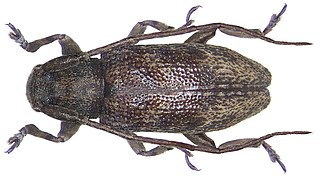Francis Polkinghorne Pascoe was an English entomologist mainly interested in beetles.
Acanthocinini is a tribe of longhorn beetles of the subfamily Lamiinae. It was described by Blanchard in 1845.

Apomecynini is a tribe of longhorn beetles of the subfamily Lamiinae.

Pteropliini is a tribe of longhorn beetles of the subfamily Lamiinae.

Glenea is a genus of longhorn beetles belonging to the family Cerambycidae, subfamily Lamiinae.

Tmesisternus is a genus of longhorn beetles belonging to the family Cerambycidae, subfamily Lamiinae.

Ropica is a genus of beetles in the family Cerambycidae, containing the following species:

Sybra is a genus of beetles in the family Cerambycidae, containing the following species:

Astathes is a genus of longhorn beetles of the subfamily Lamiinae.

Bacchisa is a genus of longhorn beetles of the subfamily Lamiinae.

Cacia is a genus of longhorn beetles of the subfamily Lamiinae.

Coptops is a genus of longhorn beetles of the subfamily Lamiinae, containing the following species:

Planodes is a genus of longhorn beetles of the subfamily Lamiinae, containing the following species:
Corrhenes is a genus of longhorn beetles of the subfamily Lamiinae, containing the following species:

Pterolophia is a genus of longhorn beetles of the subfamily Lamiinae, containing the following species:

Rhytiphora is a genus of flat-faced longhorn beetles in the Pteropliini tribe of the subfamily Lamiinae. The genus was first described in 1835 by Jean Guillaume Audinet-Serville.
Stesilea is a genus of longhorn beetles of the subfamily Lamiinae, containing the following species:
Serixia is a genus of longhorn beetles of the subfamily Lamiinae, containing the following species:

Parastesilea scutellaris is a species of beetle in the family Cerambycidae. It was described by Francis Polkinghorne Pascoe in 1865, originally under the genus Stesilea. It is known from Sulawesi.
Serixia prolata is a species of beetle in the family Cerambycidae. It was described by Francis Polkinghorne Pascoe in 1858.













